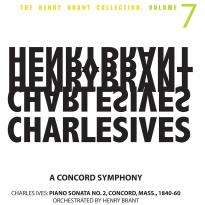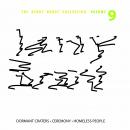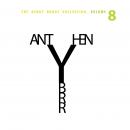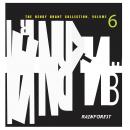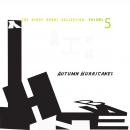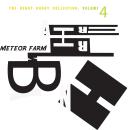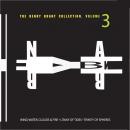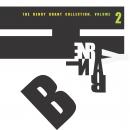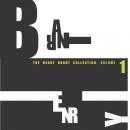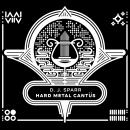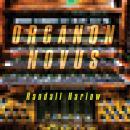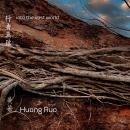Henry Brant Collection Vol. 7
Henry Brant Collection Vol. 7
Amsterdam, Netherlands
| The Henry Brant Collection, Vol. 7iTunes Artist's PageiTunes Album Page | |||
|---|---|---|---|
| Song Title | Time | Price | |
| 1. | Piano Sonata No. 2, "Concord Sonata" (arr. H. Brant): I. Emerson | 18:26 | |
| 2. | Piano Sonata No. 2, "Concord Sonata" (arr. H. Brant): II. Hawthorne | 14:53 | |
| 3. | Piano Sonata No. 2, "Concord Sonata" (arr. H. Brant): III. the Alcotts | 06:07 | $0.99 |
| 4. | Piano Sonata No. 2, "Concord Sonata" (arr. H. Brant): IV. Thoreau | 12:14 | |
Orchestral transcription of Charles Ives' Piano Sonata No. 2 (Concord, Mass., 1840-1860)
Charles Ives (1874-1954), America's greatest composer, and Henry Brant (b. 1913), America's greatest orchestrator never met in person. In the transcendental work of this piece, however, they did.
Ives's Concord Sonata (1920), a tour de force for any virtuoso pianist, has long been recognized as one of the most important and far-seeing works of the 20th century. When Henry Brant started practicing it in 1957 he saw the potential it had for becoming the Great American Symphony. Henry Cowell encouraged him in this venture, and for the next 36 years, on and off, Brant worked away at reimagining the work in orchestral terms. His experience as an all-round film composer/orchestrator came in handy: he actually composed much of the original scores to Cleopatra and 2001: A Space Odyssey.
The connection between Ives and Brant had already been established when Brant adopted his idea of spatially-separated musicians, as found in The Unanswered Question. What Ives did once, though, Brant has now done in over 100 spatial compositions.
As he says: "Ives's music taught me that there are no limitations as to what can be expressed in music. My orchestration is partly in recognition for all I've learned from him. What I had to do was to imagine that symphony. I didn’t try to orchestrate in Ives's style. For that, I would have needed a conception of life just as complex as Ives had. I also wanted the work to be accessible to conductors, to encourage them to program more works of his. So, A Concord Symphony is influenced by my own conceptions, much as Ravel's or Schoenberg's orchestrations of other composer's work."
The Piano Sonata No. 2, Concord, Mass., 1840-60 is a musical impression of the literary figures associated with transcendentalism there: in the works of Ralph Waldo Emerson, Nathaniel Hawthorne, Louisa May and Amos Bronson Alcott, and Henry David Thoreau.
Brant's orchestral version was premiered in 1995. This performance from 2000 presents the Amsterdam Concertgebouw Orchestra conducted by Dennis Russell Davies.
Henry Brant's textbook on orchestration, Textures & Timbres, begun in the 1940s was published in 2008.
Apparently we had been looking in the wrong place: the Great American Symphony turns out to be a Sonata after all.
"This is, as far as I know, the only piece which, every time I play it or turn to it, seems unfinished," Charles Ives wrote of the "Emerson" movement of his piano sonata No. 2, Concord Mass., 1840-1860. More than half a century after the Concord Sonata's premiere in 1939, a composer profoundly influenced by Ives agreed with him. Henry Brant thought the work cried out for orchestration. "I sensed that here, potentially, was a tremendous orchestral piece [that] might well become the 'Great American Symphony' that we had been seeking for years." While the musical Moby Dick no longer obsesses us as it did in the 1950's when Brant first considered the project, he has "discovered" a significant orchestral work in its own right. The premiere of A Concord Symphony took place in 1995, and this release, the seventh volume in Innova's laudable Brant collection, is its first commercial recording.
Nothing less than a masterstroke by this talented orchestrator, this is a brilliant realisation that takes the sonata to new depths of understanding and new heights of expression. While an original can never be improved upon per se, A Concord Symphony captures the sonata's latent orchestral timbre so convincingly that it certainly stands a credible equal.
"Emerson" opens in an epic, growing sweep, with central allusions to Beethoven's Fifth taking on new-found emphasis in symphonic form. But it is the "Hawthorne" movement that best justifies Brant's project. The intrusion of "outside" music such as the circus band gains immeasurably from the rousing trumpets, blaring trombones, and twittering piccolos-creating the actual sound of a marching band rather than its pianistic approximation. Brant's use of hushed, shimmering strings intermittently provide a mystical backdrop. While the pleasure of the pure pianism of the sonata is missed, dissonances here and throughout ring more pungently and clearer with the timbre of different instruments. Woodwinds provide such a perfect fit for the opening motif of "The Alcotts" that it's hard to believe this was once piano music. Strings-at times lush, at times weeping- are aptly featured in the transcendental finale, "Thoreau".
In this live recording from 2000, Dennis Russell Davies aids Brant's task with a keen reading. That the Concertgebouw Orchestra sounds wonderfully redolent of Americana only shows just how effectively Brant wrought this orchestration.
- Andrew Druckenbrod, Gramophone
This is not merely a Concord transferred to orchestra, and Brant was wise to give it a separate name. There are passages I might not necessarily have recognized, so changed is the music's texture - but the spirit is devoutly maintained. It's a new work, a new Ives symphony, with far more chamber-like orchestration than his other symphonies, as was necessary to bring the pianistic content across. It is unheard before, and yet strangely familiar. It is faithful to the original with a devotion and intelligence that go beyond mere transcription. I look forward to falling in love with it all over again.
- Kyle Gann, Postclassic
Best of 2007
Henry Brant/Charles Ives: "A Concord Symphony" (Innova)‹The Minnesota-based label, an offshoot of the American Composers Forum, hits the big time with this heroic work, Brant¹s orchestration of Ives's "Concord" Piano Sonata. No less than Dennis Russell Davies and the Royal Concertgebouw Orchestra do the honors.
- Russell Platt, The New Yorker
This is an orchestration by Henry Brant of Charles Ives's Piano Sonata No 2, Concord Mass., 1840-60. Ives worked long at the sonata, incorporating material from 1904, and producing a revised edition of the published work in 1947. There are in the sonata hints for a possible future orchestration in that there is an optional viola part near the end of the first movement, and in the finale a brief appearance for flute. But Brant's magisterial achievement, which was equally long in gestation (1958-94), is of course an entirely original conception of the piece, a viable and impressive addition to the concert repertoire.
... Ives starts the work in full knowledge he too will excite controversy.
- Robert Anderson, Music and Vision
For all that one may wonder at the choices of orchestration, this Concord Symphony simply works. It translates Ives’ vision into a different form, and does so extremely effectively. It gives the listener a new perspective on the brilliant work that is the Concord Sonata. This recording is certainly an essential addition to any Ives collection.
- Kirk McElhearn, Music Web International
